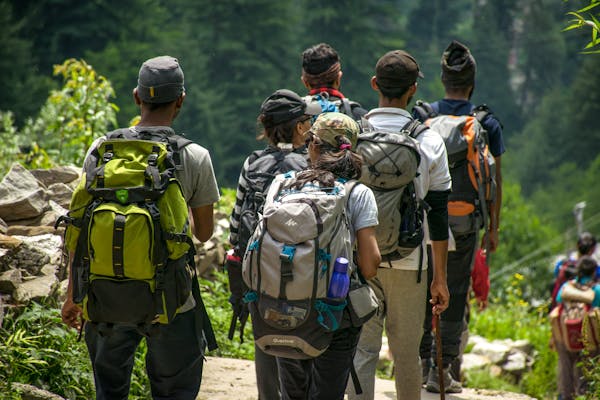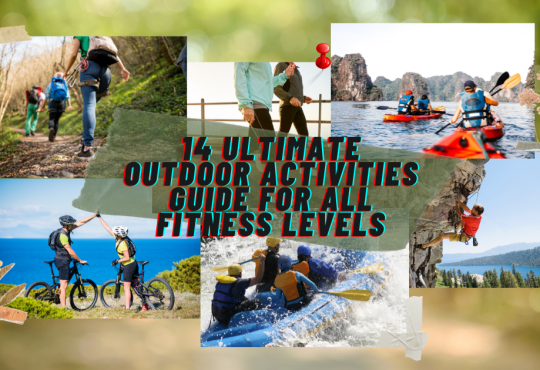Hiking is an exciting way to immerse yourself in nature, improve your physical health, and find peace of mind. For those new to hiking, stepping onto the trail can bring a mix of excitement and uncertainty. Knowing what to expect, what to bring, and how to handle the challenges that come with outdoor adventures is key to ensuring a rewarding and enjoyable experience. This guide will provide detailed tips for new hikers to help you navigate your first trails with confidence, stay safe, and make the most of your hiking journey.

1. Start Small: Choose the Right Trail for Beginners
Starting small is one of the most critical tips for new hikers. Hiking is not a race, and tackling difficult trails right away can lead to frustration, exhaustion, or even injury. It’s essential to choose trails that match your current fitness level and outdoor experience.
- Research the Trail: Before embarking on any hike, spend time researching potential trails. Websites and apps like AllTrails, Hiking Project, and Gaia GPS provide detailed trail descriptions, maps, elevation profiles, and user reviews. Many platforms also offer filters to help you find beginner-friendly options.
- Understand Trail Ratings: Trails are typically rated as easy, moderate, or difficult based on length, elevation gain, and terrain. As a new hiker, opt for easy or beginner-friendly trails. These trails are usually shorter (2-5 miles round trip), with minimal elevation gain and well-marked paths. Avoid technical trails that require scrambling or navigation through rugged terrain until you’re more experienced.
- Elevation Gain and Altitude: Consider both distance and elevation gain. Even a short trail can feel challenging if it has significant elevation change. As a guideline, an elevation gain of about 500–800 feet per mile is considered moderate. If you’re hiking at higher altitudes (above 5,000 feet), you may also need to account for altitude sickness, which can cause headaches, nausea, and dizziness.
- Start Close to Home: Choose a local trail to begin with so you can familiarize yourself with hiking without worrying about travel logistics. Many cities and towns have nearby parks, nature reserves, or shorter urban hikes that are perfect for beginners.
2. Invest in Proper Footwear
Your feet will carry you through the hike, so it’s essential to wear the right shoes. Proper footwear is one of the most valuable tips for new hikers. Wearing inadequate shoes can lead to blisters, sore feet, or injuries, turning what should be an enjoyable experience into an uncomfortable one.
- Hiking Boots vs. Trail Running Shoes: Hiking boots provide excellent ankle support, grip, and protection, making them ideal for more rugged terrain or longer hikes. If you’re sticking to well-maintained trails with less uneven ground, trail running shoes are a lighter option. The key is to ensure the shoes offer good traction and foot support.
- Waterproof Footwear: If you plan to hike in wet or rainy conditions, waterproof hiking boots or shoes are a smart choice. Many boots come with Gore-Tex or similar waterproof membranes that keep your feet dry in mud, puddles, or light rain.
- Fit and Comfort: Take time to find shoes that fit well. Hiking shoes should feel snug without being too tight, with enough room for your toes to wiggle. Poorly fitting shoes can lead to painful blisters, especially on long hikes. Visit an outdoor store and try on multiple pairs, and consider wearing the socks you intend to hike in when trying on shoes.
- Breaking in Your Footwear: New shoes or boots should be broken in before you take them on a long hike. Wear them around the house, on errands, or during short walks to soften them up and reduce the risk of blisters on the trail.
3. Carry Essential Gear
Being well-prepared with the right gear can make your hike much more enjoyable and safe. Knowing what to pack is one of the most practical tips for new hikers, as it ensures you’re ready for whatever nature throws your way.
- Water and Hydration System: Staying hydrated is vital, especially when hiking in hot or dry climates. Bring at least 1 liter of water for every 2 hours of hiking. Hydration bladders (such as CamelBaks) allow you to sip water regularly without needing to stop. If you’re heading out for a longer hike, consider carrying a water filter or purification tablets to treat water from natural sources along the way.
- Snacks and Nutrition: Hiking can burn a lot of calories, so it’s important to bring snacks that provide energy and nutrients. Trail mix, protein bars, nuts, jerky, and dried fruit are great options. For longer hikes, pack easy-to-eat sandwiches or wraps. Having enough fuel will keep your energy levels steady and help you recover faster.
- Navigation Tools: Many beginner hikers rely on their smartphones for navigation. While apps like AllTrails or Gaia GPS are great tools, don’t assume you’ll always have cell service. It’s essential to carry a backup form of navigation, such as a physical map or a GPS device. Learning how to use a compass is also a good skill to have, as it provides a reliable way to orient yourself in case of emergency.
- First Aid Kit: Even on short hikes, accidents can happen. A basic first aid kit should include bandages, antiseptic ointments, tweezers, pain relievers, and blister treatments. It’s also important to carry any personal medications, such as allergy medication or an epinephrine injector if you’re allergic to bee stings.
- Sun Protection: Sunburn can occur even on cloudy days, so always wear sunscreen with at least SPF 30, and reapply it every two hours. Wearing sunglasses with UV protection and a wide-brimmed hat will help protect your face and eyes from the sun’s rays.
- Headlamp or Flashlight: Even if you don’t plan to hike after dark, always carry a headlamp or small flashlight. Sometimes hikes take longer than expected, and you may find yourself navigating back in low-light conditions. Make sure your light source has fully charged batteries or a backup set.
4. Dress in Layers and Wear the Right Clothing
Hiking requires you to be prepared for a range of weather conditions, even if you start with sunny skies. One of the best tips for new hikers is to dress in layers, allowing you to adjust your clothing as the weather changes throughout your hike.
- Moisture-Wicking Base Layer: Your base layer, the layer closest to your skin, should be made of moisture-wicking materials such as merino wool or synthetic fabrics. This will pull sweat away from your skin and keep you dry, helping to prevent chafing or feeling chilled. Avoid cotton, which retains moisture and takes a long time to dry.
- Insulating Mid-Layer: Your mid-layer is designed to keep you warm by trapping heat. Depending on the temperature, you may choose a lightweight fleece, down jacket, or a synthetic insulated jacket. This layer is particularly important if you’ll be hiking at higher elevations or in colder weather.
- Waterproof Outer Layer: A good rain jacket or windbreaker is essential for protection against the elements. Even on sunny days, weather in the mountains can change quickly, and a sudden rainstorm can leave you drenched. A waterproof jacket with a hood will protect you from rain and wind while still being breathable.
- Hiking Pants or Shorts: Opt for lightweight, durable hiking pants or shorts made from quick-drying materials. Convertible pants (those that can zip off into shorts) are great for variable temperatures. If you’re hiking in colder conditions, thermal or fleece-lined pants can provide extra warmth.
5. Understand and Practice Leave No Trace Principles
One of the most essential tips for new hikers is to respect the environment by following the Leave No Trace principles. These guidelines ensure that the natural spaces we enjoy remain pristine for future generations and protect the wildlife and ecosystems that inhabit them.
- Plan Ahead and Prepare: Understanding the regulations, potential hazards, and environmental sensitivities of the area you’re hiking in is key. Make sure you have the proper permits if required and are aware of any seasonal restrictions or closures.
- Stick to Designated Trails: Traveling off-trail can damage fragile ecosystems and disturb wildlife. Always stick to established trails and avoid creating new paths or shortcuts. If you’re hiking in more remote areas, use durable surfaces like rocks or gravel to minimize your impact.
- Pack Out What You Pack In: All trash, food wrappers, and waste should be packed out. This includes biodegradable items like fruit peels or cores, which can still disrupt local wildlife and don’t decompose quickly.
- Dispose of Waste Properly: If you need to go to the bathroom while hiking, dig a “cat hole” at least 6-8 inches deep and 200 feet away from water sources or the trail. Use biodegradable toilet paper and pack out used toilet paper if required by park regulations.
- Respect Wildlife: Observe animals from a distance and avoid feeding them. Feeding wildlife can alter their natural behaviors and lead to dangerous interactions. Store food securely in a bear canister or use a bear bag if you’re hiking in bear country.
6. Learn Basic Navigation Skills
As a new hiker, you may be tempted to rely solely on technology to guide you, but learning traditional navigation skills is essential for safety. Technology can fail, and cell service is often unreliable in the wilderness, so understanding how to read a map and use a compass is an invaluable skill.
- Download Offline Maps: Before heading out, download the map of your trail and surrounding area for offline use. Many hiking apps allow you to do this, so even if you lose service, you can still track your progress and location.
- Practice Using a Compass: A compass may seem like an outdated tool, but it can be a lifesaver in situations where you’ve lost the trail or need to find your bearings. Learn the basics of orienting a map with a compass, and practice using it in familiar areas before relying on it in the backcountry.
- Look for Landmarks: Keep an eye out for prominent natural features such as mountains, rivers, or rock formations to help orient yourself. This can be especially useful if you need to retrace your steps or if you’re navigating through areas with less defined trails.
7. Hike with a Buddy or Inform Someone of Your Plan
While solo hiking can be a meditative experience, it’s not recommended for beginners. Hiking with a partner or group provides an added layer of safety and makes the experience more enjoyable. If you choose to hike alone, ensure someone knows your plans.
- Hike with a Friend or Group: Having a hiking buddy means you’ll have someone to help in case of injury, a navigational error, or an emergency. Plus, hiking with others can make the experience more fun and allow you to share the adventure.
- Tell Someone Your Plan: If you’re hiking solo, always inform a trusted person of your route, estimated start and end times, and any alternate plans. This way, if something goes wrong and you don’t return on time, they’ll know where to start looking.
8. Pace Yourself and Listen to Your Body
Hiking can be physically demanding, and new hikers often make the mistake of pushing themselves too hard or going too fast. One of the most valuable tips for new hikers is to pace yourself and listen to your body’s signals.
- Set a Comfortable Pace: Start your hike at a steady, manageable pace that allows you to conserve energy for the entire hike. Hiking too quickly can lead to fatigue, dehydration, or injury, especially on longer or steeper trails. It’s better to hike slowly and enjoy the journey than to rush and risk burnout.
- Take Regular Breaks: Short, frequent breaks can help prevent muscle fatigue and allow you to enjoy the scenery. Aim to rest every 30 to 60 minutes, or whenever you feel tired. Use these breaks to hydrate, eat a snack, or simply take in the view.
- Hydrate and Refuel Often: Staying hydrated and eating regularly will help maintain your energy levels. Drink small amounts of water consistently throughout the hike, rather than waiting until you’re thirsty. Similarly, snack on small portions of trail mix or energy bars every couple of hours to keep your blood sugar steady.
- Recognize Signs of Overexertion: Listen to your body. If you start feeling dizzy, lightheaded, or overly tired, stop immediately, drink some water, and rest. Don’t push through fatigue or discomfort, as this can lead to injury or serious health issues like heat exhaustion or altitude sickness.
9. Be Prepared for Wildlife Encounters
Encountering wildlife is one of the highlights of hiking, but it’s also essential to be prepared. Many animals are shy and avoid humans, but some may come closer if they feel threatened or are attracted by food. Learning how to react during a wildlife encounter is one of the most important tips for new hikers.
- Maintain a Safe Distance: Always observe wildlife from a distance. Use binoculars or a camera zoom to get a closer look without approaching animals. Most parks recommend staying at least 100 yards away from bears and 25 yards away from other wildlife, such as deer or elk.
- Make Noise to Avoid Surprises: In areas where large animals like bears or moose are common, it’s important to make noise as you hike. Talking, clapping, or using a bear bell can help alert wildlife to your presence and prevent startling an animal.
- Carry Bear Spray: If you’re hiking in bear country, carrying bear spray is a good precaution. Bear spray is a highly effective deterrent in the event of a close encounter. Learn how to use it before you head out, and keep it in an easily accessible place.
- Store Food Properly: Never leave food unattended, and always store it in a bear-proof container or bag, especially when camping. Hanging food at least 10 feet off the ground and 4 feet away from the tree trunk will help keep bears and other animals away from your camp.
10. Enjoy the Experience
Finally, the most important tip for new hikers is to enjoy the experience. Hiking is about more than just reaching the summit or completing a trail. It’s about immersing yourself in nature, finding peace, and taking in the beauty of the natural world. Slow down, breathe deeply, and appreciate the sights, sounds, and smells around you.
- Take Photos, But Be Present: While capturing memories with your camera or smartphone is great, remember to take time to enjoy the moment without distractions. Nature has a way of offering calm and perspective that’s best experienced in the present.
- Reflect and Unplug: Hiking offers a wonderful opportunity to disconnect from the stresses of daily life. Use the time on the trail to clear your mind, meditate, or simply enjoy the quiet.
- Celebrate Your Accomplishments: Whether you complete a short beginner hike or conquer a longer trail, take pride in your achievements. Every step you take builds your confidence and paves the way for future adventures.
For those eager to explore the outdoors, these tips for new hikers provide a solid foundation for a safe and enjoyable hiking experience. From selecting the right gear and pacing yourself to respecting nature and being mindful of your surroundings, following these guidelines will help you navigate your first hikes with confidence. Over time, as you gain more experience, you’ll be able to tackle more challenging trails and explore new landscapes. Remember, the goal of hiking is not just to reach the destination but to enjoy the journey along the way. Happy trails!





